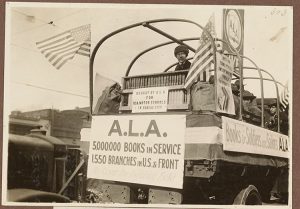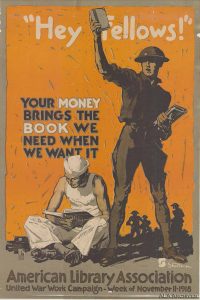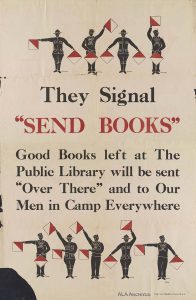ENTRY INTO THE GREAT WAR
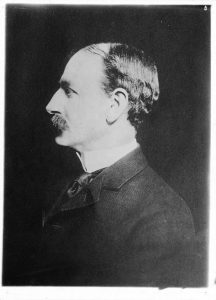
Just weeks after the United States’ entry into the Great War, the American Library Association appointed a preliminary committee to establish the role of libraries and librarians in the war effort. The committee came up with suggestions that would involve the Association in providing information about the war to the public through libraries and periodicals. But another idea appealed to them even more, which was supplying reading materials to servicemen both in US camps and overseas. The idea gained momentum and launched the largest public engagement program that the ALA had ever participated in at the time.
During the Association’s June 1917 Annual Conference, the first ALA conference after the US entry into the war, the preliminary committee came to an understanding that there would be a great need for books:
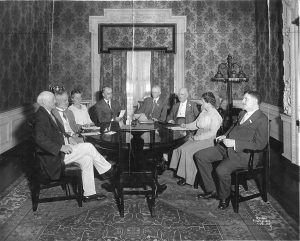
For within a few months we shall have over a half million men in cantonment, training camp, or at the front. Among them will be men hitherto dependent upon books, men trained to the use of books, men untrained to their use but who might, under the unusual conditions, be brought to it, men taken from professions, arts, and trades in which books supplied might later benefit them, and men of all sorts to whom the inactive hours of camp or field bring depressing tedium and dangerous temptation, and to whom merely recreative [sic] reading would be a saving resource.
At the conference, the committee became a permanent Library War Service committee and was chaired by James I. Wyer, Jr. Other distinguished librarians served with Wyer; Arthur Bostwick, Richard Bowker, Gratia Countryman, Matthew Dudgeon, Alice Tyler, Edwin Anderson, and Frank Hill. The roster of the committee changed as members were no longer able to serve, but Wyer, Anderson, Hill, and Electra Doren, who replaced Tyler in 1917, served from 1917 to 1920 and provided stability within the group.
Herbert Putnam, the Librarian of Congress, and who was the chair of the preliminary committee, became the director of the Library War Service. Carl Milam would later take over the leadership of the Library War Service in December 1918 until the service’s end in 1920.
THE MILLION DOLLAR CAMPAIGN
In August of 1917, the War Library Bulletin announced that the ALA Finance Committee determined that a million dollars would be needed to carry out the work of the Library War Service. The first big push for raising funds was set for the following September in a fundraising campaign called “Library War Fund Week.” The funds would pay for books, library buildings, salaries for librarians, indexing systems, and subscriptions to periodicals. By January 1918, the Library War Service raised over $1.5 million, collected more than half a million books from the public, thirty-three library buildings were erected or under construction, and hundreds of branch libraries were established in YMCA and Knights of Columbus buildings in military camps.
Book drives yielded different results. In April 1918, the ALA had collected over 3 million books from the public, however there were some problems with the donations. While the demand for non-fiction was high from soldiers, most of the books collected were fiction. This caused the Library War Service to depend on the public to provide novels and other fiction for soldiers and to focus their spending on non-fiction texts. The condition of many donated books was also wanting, many were in poor shape and unusable. Some books were unsuitable for use by servicemen, such as badly outdated textbooks and family bibles.
The initial goal of the Library War Service was to provide a book for every man and while that goal became a struggle at the end of the war, the Library War Service was able to accomplish a great deal. By the end of the Library War Service in 1920, the ALA raised over $5 million from public donations, built thirty-six camp libraries, and distributed 10 million books and other reading materials.
A COMBINED EFFORT
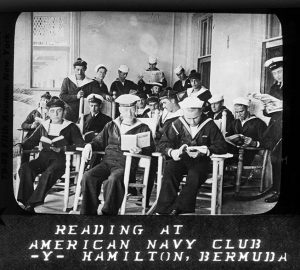
The endeavor of providing library services to soldiers could not be done by the American Library Association alone. While the ALA took on a great task in organizing books drives, fundraising campaigns, and organizing personnel, it also partnered up with other volunteer organizations and military departments to expand their reach.
The ALA worked in cooperation with the Young Men’s Christen Association (YMCA) and the Young Women’s Christen Association (YWCA), making use of their facilities established on or near military camps. The ALA also worked with the American Red Cross, Knights of Columbus, the Jewish Welfare Board, and the Commission on Training Camp Activities, a part of the United States War Department.
Despite the cooperation between the Association and other organizations, the relationship between the ALA and these organizations were not always smooth. In the August 1918 issue of War Libraries, the ALA made it clear that the Library War Service was not merging with the other groups, despite combining efforts in book and funding drives. Friction between hospital library service representatives and Red Cross representatives was recorded in letters, describing less than friendly interactions. And a member of the Special Libraries Association openly criticized the ALA for not having a special librarian included in the management of the Library War Service and that SLA had no representatives on any committee concerning the war service.

